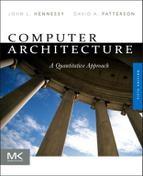T
Tag
AMD Opteron data cache, B-12 to B-14
ARM Cortex-A8, 115
cache optimization, 79–80
dynamic scheduling, 177
invalidate protocols, 357
memory hierarchy basics, 74
memory hierarchy basics, 77–78
virtual memory fast address translation, B-46
write strategy, B-10
Tag check (TC)
MIPS R4000, C-63
R4000 pipeline, B-62 to B-63
R4000 pipeline structure, C-63
write process, B-10
Target address
branch penalty reduction, C-22 to C-23
branch-target buffer, 206
control flow instructions, A-17 to A-18
GPU conditional branching, 301
Intel Core i7 branch predictor, 166
MIPS control flow instructions, A-38
MIPS implementation, C-32
MIPS R4000, C-25
pipeline branches, C-39
RISC instruction set, C-5
Target instructions
branch delay slot scheduling, C-24
as branch-target buffer variation, 206
GPU conditional branching, 301
Task-level parallelism (TLP), definition, 9
TB See Translation buffer (TB)
TC See Tag check (TC)
TCAs See Target channel adapters (TCAs)
TCO See Total Cost of Ownership (TCO)
TDMA See Time division multiple access (TDMA)
TDP See Thermal design power (TDP)
Test-and-set operation, synchronization, 388
TFT See Thin-film transistor (TFT)
Thermal design power (TDP), power trends, 22
Thrash, memory hierarchy, B-25
Thread Block
Fermi GTX 480 GPU flooplan, 295
function, 294
GPU hardware levels, 296
GPU Memory performance, 332
GPU programming, 289–290
Grid mapping, 293
mapping example, 293
multithreaded SIMD Processor, 294
NVIDIA GPU computational structures, 291
NVIDIA GPU Memory structures, 304
PTX Instructions, 298
Thread Block Scheduler
Fermi GTX 480 GPU flooplan, 295
GPU, 296
Grid mapping, 293
multithreaded SIMD Processor, 294
Thread-level parallelism (TLP)
advanced directory protocol case study, 420–426
Amdahl’s law and parallel computers, 406–407
centralized shared-memory multiprocessors
basic considerations, 351–352
cache coherence, 352–353
cache coherence enforcement, 354–355
cache coherence example, 357–362
cache coherence extensions, 362–363
invalidate protocol implementation, 356–357
SMP and snooping limitations, 363–364
snooping coherence implementation, 365–366
snooping coherence protocols, 355–356
definition, 9
directory-based cache coherence
case study, 418–420
protocol basics, 380–382
protocol example, 382–386
DSM and directory-based coherence, 378–380
IBM Power7, 215
from ILP, 4–5
inclusion, 397–398
Intel Core i7 performance/energy efficiency, 401–405
memory consistency models
basic considerations, 392–393
compiler optimization, 396
programming viewpoint, 393–394
relaxed consistency models, 394–395
speculation to hide latency, 396–397
MIMDs, 344–345
multicore processor performance, 400–401
multicore processors and SMT, 404–405
multiprocessing/multithreading-based performance, 398–400
multiprocessor architecture, 346–348
multiprocessor cost effectiveness, 407
multiprocessor performance, 405–406
multiprocessor software development, 407–409
vs. multithreading, 223–224
parallel processing challenges, 349–351
single-chip multicore processor case study, 412–418
Sun T1 multithreading, 226–229
Thread Processor Registers, definition, 292
Thread Scheduler in a Multithreaded CPU, definition, 292
Thread of SIMD Instructions
characteristics, 295–296
CUDA Thread, 303
Grid mapping, 293
lane recognition, 300
scheduling example, 297
terminology comparison, 314
vector/GPU comparison, 308–309
Thread of Vector Instructions, definition, 292
Throughput See also Bandwidth
Google WSC, 470
ILP, 245
instruction fetch bandwidth, 202
Intel Core i7, 236–237
kernel characteristics, 327
memory banks, 276
multiple lanes, 271
parallelism, 44
performance considerations, 36
performance trends, 18–19
pipelining basics, C-10
precise exceptions, C-60
server benchmarks, 40–41
servers, 7
uniprocessors, TLP
basic considerations, 223–226
fine-grained multithreading on Sun T1, 226–229
superscalar SMT, 230–232
WSCs, 434
Time-cost relationship, components, 27–28
Tomasulo’s algorithm
advantages, 177–178
dynamic scheduling, 170–176
FP unit, 185
MIP FP unit, 173
register renaming vs. ROB, 209
Top Of Stack (TOS) register, ISA operands, A-4
TOS See Top Of Stack (TOS) register
Total Cost of Ownership (TCO), WSC case study, 476–479
Total store ordering, relaxed consistency models, 395
Tournament predictors
ILP for realizable processors, 216
local/global predictor combinations, 164–166
Toy programs, performance benchmarks, 37
TP See Transaction-processing (TP)
Tradebeans benchmark, SMT on superscalar processors, 230
Transaction Processing Council (TPC)
parallelism, 44
performance results reporting, 41
server benchmarks, 41
TPC-B, shared-memory workloads, 368
TPC-C
IBM eServer p5 processor, 409
multiprocessing/multithreading-based performance, 398
multiprocessor cost effectiveness, 407
single vs. multiple thread executions, 228
WSC services, 441
TPC-D, shared-memory workloads, 368–369
TPC-E, shared-memory workloads, 368–369
Transistors
clock rate considerations, 244
dependability, 33–36
energy and power, 23–26
ILP, 245
performance scaling, 19–21
processor comparisons, 324
processor trends, 2
RISC instructions, A-3
shrinking, 55
static power, 26
technology trends, 17–18
Translation buffer (TB)
virtual memory block identification, B-45
virtual memory fast address translation, B-46
Translation lookaside buffer (TLB)
address translation, B-39
AMD64 paged virtual memory, B-56 to B-57
ARM Cortex-A8, 114–115
memory hierarchy, B-48 to B-49
memory hierarchy basics, 78
Opteron, B-47
Opteron memory hierarchy, B-57
RISC code size, A-23
shared-memory workloads, 369–370
speculation advantages/disadvantages, 210–211
strided access interactions, 323
Virtual Machines, 110
virtual memory block identification, B-45
virtual memory fast address translation, B-46
virtual memory page size selection, B-47
virtual memory protection, 106–107
True speedup, multiprocessor performance, 406
Two-way conflict misses, definition, B-23
Two-way set associativity
ARM Cortex-A8, 233
cache miss rates, B-24
cache miss rates vs. size, B-33
cache optimization, B-38
cache organization calculations, B-19 to B-20
multiprogramming workload, 374–375
nonblocking cache, 84
Opteron data cache, B-13 to B-14
2:1 cache rule of thumb, B-29
virtual to cache access scenario, B-39
“Typical” program, instruction set considerations, A-43
..................Content has been hidden....................
You can't read the all page of ebook, please click here login for view all page.
